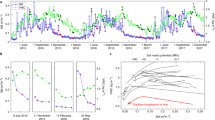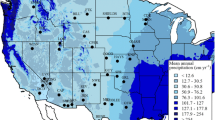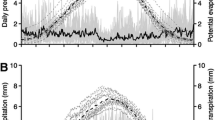Abstract
The ‘pulse–reserve’ conceptual model—arguably one of the most-cited paradigms in aridland ecology—depicts a simple, direct relationship between rainfall, which triggers pulses of plant growth, and reserves of carbon and energy. While the heuristics of ‘pulses’, ‘triggers’ and ‘reserves’ are intuitive and thus appealing, the value of the paradigm is limited, both as a conceptual model of how pulsed water inputs are translated into primary production and as a framework for developing quantitative models. To overcome these limitations, we propose a revision of the pulse–reserve model that emphasizes the following: (1) what explicitly constitutes a biologically significant ‘rainfall pulse’, (2) how do rainfall pulses translate into usable ‘soil moisture pulses’, and (3) how are soil moisture pulses differentially utilized by various plant functional types (FTs) in terms of growth? We explore these questions using the patch arid lands simulation (PALS) model for sites in the Mojave, Sonoran, and Chihuahuan deserts of North America. Our analyses indicate that rainfall variability is best understood in terms of sequences of rainfall events that produce biologically-significant ‘pulses’ of soil moisture recharge, as opposed to individual rain events. In the desert regions investigated, biologically significant pulses of soil moisture occur in either winter (October–March) or summer (July–September), as determined by the period of activity of the plant FTs. Nevertheless, it is difficult to make generalizations regarding specific growth responses to moisture pulses, because of the strong effects of and interactions between precipitation, antecedent soil moisture, and plant FT responses, all of which vary among deserts and seasons. Our results further suggest that, in most soil types and in most seasons, there is little separation of soil water with depth. Thus, coexistence of plant FTs in a single patch as examined in this PALS study is likely to be fostered by factors that promote: (1) separation of water use over time (seasonal differences in growth), (2) relative differences in the utilization of water in the upper soil layers, or (3) separation in the responses of plant FTs as a function of preceding conditions, i.e., the physiological and morphological readiness of the plant for water-uptake and growth. Finally, the high seasonal and annual variability in soil water recharge and plant growth, which result from the complex interactions that occur as a result of rainfall variability, antecedent soil moisture conditions, nutrient availability, and plant FT composition and cover, call into question the use of simplified vegetation models in forecasting potential impacts of climate change in the arid zones in North America.








Similar content being viewed by others
References
Bachelet D, Wondzell SM, Reynolds JF (1988) A simulation model using environmental cues to predict phenologies of winter and summer annuals in the northern Chihuahuan Desert. In: Marani A (ed) Advances in environmental modelling. Elsevier, Amsterdam, pp 235–260
Beatley JC (1974) Phenological events and their environmental triggers in Mojave desert ecosystems. Ecology 55:856–863
Briones O, Montaña C, Ezcurra E (1996) Competition between three Chihuahuan desert species: evidence from plant size-distance relations and root distribution. J Veg Sci 7:453–460
Burgess TL (1995) Desert grassland, mixed shrub savanna, shrub steppe, or semidesert scrub? The dilemma of coexisting growth forms. In: McClaran MP, Van Devender TR (eds) The desert grassland. The University of Arizona Press, Tucson, pp 31–67
Campbell GS, Jungbauer JD Jr, Shiozawa S, Hungerford RD (1993) A one-parameter equation for water sorption isotherm of soils. Soil Sci 156:302–306
Chen J-L, Reynolds JF (1997) GePSi: a generic plant simulator based on object-oriented principles. Ecol Model 94:53–66
Chesson P, Huntly N (1993) Temporal hierarchies of variation and the maintenance of diversity. Plant Species Biol 8:195–206
Cohen RA (1999) An introduction to PROC LOESS for local regression. (SUGI Proceedings) SAS Institute, Cary, N.C. http://www.ats.ucla.edu/stat/SAS/library/
Conley W, Conley MR, Karl TR (1992) A computational study of episodic events and historical context in long-term ecological process: climate and grazing in the northern Chihuahuan Desert. Coenoses 7:55–60
Dougherty RL, Lauenroth WK, Singh JS (1996) Response of a grassland cactus to frequency and size of rainfall events in a North American shortgrass steppe. J Ecol 84:177–183
Evenari M, Noy-Meir I, Goodall DW (1985) Ecosystems of the world. Hot deserts and arid shrublands. Elsevier, Amsterdam
Fernández RJ, Reynolds JF (2000) Potential growth and drought tolerance of eight desert grasses: lack of a trade-off? Oecologia 123:90–98
Forseth IN, Ehleringer JR, Werk KS, Cook CS (1984) Field water relations of Sonoran Desert annuals. Ecology 65:1436–1444
Franco AC, Nobel PS (1991) Influence of root distribution and growth on predicted water uptake and interspecific competition. Oecologia 82:151–157
Freas KE, Kemp PR (1983) Some relationships between environmental reliability and seed dormancy in desert annual plants. J Ecol 71:211–217
Gao Q, Reynolds JF (2003) Historical shrub-grass transitions in the northern Chihuahuan Desert: modeling the effects of shifting rainfall seasonality and event size over a landscape gradient. Glob Change Biol 9:1–19
Gibbens RP, Beck RF (1988) Changes in grass basal area and forb densities over a 64-year period on grassland types of the Jornada Experimental Range. J Range Manage 41:186–192
Gile LH, Grossman RB (1967) Morphology of the argillic horizon in desert soils of southern New Mexico. Soil Sci 106:6–15
Gile LH, Peterson FF, Grossman RB (1966) Morphological and genetic sequences of carbonate accumulation in desert soils. Soil Sci 101:347–360
Gile LH, Gibbens RP, Lenz JM (1998) Soil-induced variability in root systems of creosotebush (Larrea tridentata) and tarbush (Flourensia cernua). J Arid Environ 39:57–78
Gitay H, Nobel I (1997) What are functional types and how should we seek them? In: Smith TM, Shugart HH, Woodward FI (eds) Plant functional types: their relevance to ecosystem properties and global change. Cambridge University Press, Cambridge, pp 3–19
Goldberg DE (1990) Components of resource competition in plant communities. In: Grace JB, Tilman D (eds) Perspectives on plant competition. Academic Press, San Diego
Golluscio RA, Sala OE, Lauenroth WK (1998) Differential use of large summer rainfall events by shrubs and grasses: a manipulative experiment in the Patagonian steppe. Oecologia 115:17–25
Green CR (1960) Probabilities of drought and rainy periods for selected points in the Southwestern United States. In: Institute of Atmospheric Physics (ed) Technical reports on the meteorology and climatology of arid regions. University of Arizona, Tucson, pp 28
Herbel CH, Gibbens RP (1987) Soil water regimes of loamy sands and sandy loams on arid rangelands in southern New Mexico. J Soil Water Conserv 42:442–447
Herbel CH, Gibbens RP (1989) Matric potential of clay loam soils on arid rangelands in southern New Mexico. J Range Manage 42:386–392
Higgins RW, Mo KC, Yao Y (1998) Interannual variability in the U. S. summer precipitation regime with emphasis on the southwestern monsoon. J Climatol 11:2582–2606
Hunter RB (1989) Competition between adult and seedling shrubs of Ambrosia dumosa in the Mojave Desert Great Basin. Nature 49:79–84
Jobbágy EG, Sala OE (2000) Controls of grass and shrub aboveground production in the Patagonian steppe. Ecol Appl 10:541–549
Johnson IR, Thornley JHM (1983) Vegetative crop growth model incorporating leaf area expansion and senescence, and applied to grass. Plant Cell Environ 6:721–729
Kemp PR (1983) Phenological patterns of Chihuahuan Desert plants in relation to the timing of water availability. J Ecol 71:427–436
Kemp PR, Reynolds JF (2000) Variability in phenology and production of desert ephemerals: implications for predicting resource availability for desert tortoises. Proc Annu Meet Symp Desert Tortoise Counc 24:34–39
Kemp PR, Reynolds JF (2004) Meteorological controls of ecosystem processes and their implementation into ecological models of arid lands. J Agric Meteorol (in press)
Kemp PR, Reynolds JF, Pachepsky Y, Chen JL (1997) A comparative modeling study of soil water dynamics in a desert ecosystem. Water Resour Res 33:73–90
Kemp PR, Reynolds JF, Virginia RA, Whitford WG (2003) Decomposition of leaf and root litter of Chihuahuan Desert shrubs: effects of three years of summer drought. J Arid Environ 53:21–39
Lane LJ, Romney EM, Hakonson TE (1984) Water balance calculations and net production of perennial vegetation in the northern Mojave Desert. J Range Manage 37:12–18
Lauenroth W, Sala O (1992) Long-term forage production of North American shortgrass steppe. Ecol Appl 2:397–403
Le Houérou HN, Bingham RL, Skerbek W (1988) Relationship between the variability of primary production and the variability of annual precipitation in world arid lands. J Arid Environ 15:1–18
Linacre ET (1973) A simpler empirical expression for actual evapotranspiration rates—a discussion. Agric Forest Meteorol 11:451–452
Ludwig JA, Tongway D, Freudenberger D, Noble J, Hodgkinson K (1997) Landscape ecology: function and management. Principles from Australia’s rangelands. CSIRO, Collingwood
MacMahon JA (1979) North American deserts: their floral and faunal components. In: Goodall DW, Perry RA (eds) Arid land ecosystems: structure, functioning and management (IBP 16, vol 1) Cambridge, pp 21–82
MacMahon JA, Schimpf DJ (1981) Water as a factor in the biology of North American desert plants. In: Evans DD, Thames JL (eds) Water in desert ecosystems. Dowden, Hutchinson & Ross, Stroudsburg, pp 114–171
McAuliffe JR, McDonald EV (1995) A piedmont landscape in the eastern Mojave Desert: examples of linkages between biotic and physical components. San Bernardino County Mus Assoc Q 42:53–63
Montaña C, Cavagnaro B, Briones O (1995) Soil water use by co-existing shrubs and grasses in the southern Chihuahuan Desert, Mexico. J Arid Environ 31:1–13
Moorhead DL, Reynolds JF, Fonteyn PJ (1989) Patterns of stratified soil water loss in a Chihuahuan Desert community. Soil Sci 148:244–249
Neilson RP (1986) High-resolution climatic analysis and southwest biogeography. Science 232:27–34
Nichols WD (1992) Energy budgets and resistances to energy transport in sparsely vegetated rangeland. Agric Forest Meteorol 60:221–247
Nobel PS (1976) Water relations and photosynthesis of a desert CAM plant, Agave deserti. Plant Physiol 58:576–582
Nobel PS (1997) Root distribution and seasonal production in the northwestern Sonoran desert for a C-3 subshrub, a C-4 bunchgrass, and a CAM leaf succulent. Am J Bot 84:949–955
Noy-Meir I (1973) Desert ecosystems: environment and producers. Annu Rev Ecol Syst 4:25–41
Paulsen HA, Jr, Ares FN (1962) Grazing values and management of black grama and tobosa grasslands and associated shrub ranges of the southwest. (Tech Bull 1270) US Department of Agriculture, Las Cruces
Phillips FM (1994) Environmental tracers for water movement in desert soils of the American southwest. Soil Sci Soc Amer J 58:15–24
Reynolds JF, Virginia RA, Schlesinger WH (1997) Defining functional types for models of desertification. In: Smith TM, Shugart HH, Woodward FI (eds) Plant functional types: their relevance to ecosystem properties and global change. Cambridge University Press, Cambridge, pp 194–214
Reynolds JF, Virginia RA, Kemp PR, Soyza AG de, Tremmel DC (1999) Impact of drought on desert shrubs: effects of seasonality and degree of resource island development. Ecol Monogr 69:69–106
Reynolds JF, Fernández RJ, Kemp PR (2000a) Drylands and global change: rainfall variability and sustainable rangeland production. In: Watanabe KN, Komanine A (eds) Challenge of plant and agricultural sciences to the crisis of biosphere on the earth in the 21th century. (Proceedings of the 12th Toyota conference) Landes, Austin, pp 73–86
Reynolds JF, Kemp PR, Tenhunen JD (2000b) Effects of long-term rainfall variability on evapotranspiration and soil water distribution in the Chihuahuan Desert: a modeling analysis. Plant Ecol 150:145–159
Robinson D, Vuuren MMI van (1998) Responses of wild plants to nutrient patches in relation to growth rate and life-form. In: Lambers H, Poorter H, Vuuren MMI van (eds) Variation in plant growth. Backhuys, Amsterdam, pp 237–257
Rundel PW, Nobel PS (1991) Structure and function in desert root systems. In: Atkinson D (ed) Plant root growth: an ecological perspective. (Br Ecol Soc Spec Publ 10) Blackwell, Oxford, pp 349–377
Sala OE, Lauenroth WK (1982) Small rainfall events: an ecological role in semiarid regions. Oecologia 53:301–304
Sala OE, Lauenroth WK (1985) Root profiles and the ecological effect of light rainshowers and arid and semiarid regions. Am Midl Nat 114:406–408
Samis TW, Gay LY (1979) Evapotranspiration from an arid zone plant community. J Arid Environ 2:313–321
Scanlon BR (1992) Evaluation of liquid and vapor flow in desert soils based on chlorine 36 and tritium tracers and non isothermal flow simulations. Water Resour Res 28:285–297
Scanlon BR (1994) Water and heat fluxes in desert soils. 1. Field studies. Water Resour Res 30:709–719
Schlesinger WH, Fonteyn PJ, Reiners WA (1989) Effects of overland flow on plant water relations, erosion, and soil water percolation on a Mojave Desert landscape. Soil Sci Soc Am J 53:1567–1572
Schwinning S, Sala OE (2004) Hierarchy of responses to resource pulses in arid and semi-arid ecosystems. Oecologia DOI 10.1007/s00442-1520-8
Schwinning S, Starr BI, Ehleringer JR (2003) Dominant cold desert plants do not partition warm season precipitation by event size. Oecologia 136:252–260
Sellers WD, Hill RH (1974) Arizona climate 1931–1972. University of Arizona Press, Tucson
Sheppard PR, Hughes MK, Comrie AC, Packin GD, Angersbach K (2002) The climate of the US Southwest. Clim Res 21:219–238
Smith RE, Schreiber HA (1974) Point processes of seasonal thunderstorm rainfall. 2. Rainfall depth probabilities. Water Resour Res 10:418–426
Smith SD, Herr CA, Leary KL, Piorkowski JM (1995) Soil-plant water relations in a Mojave Desert mixed shrub community: a comparison of three geomorphic surfaces. J Arid Environ 29:339–351
Tevis L Jr (1958) A population of desert ephemerals germinated by less than one inch of rain. Ecology 39:688–695
Thames JL (1979) Tucson validation site report. In: US/IBP (ed) US/IBP desert biome research memorandum 77-3. Final progress reports, validation studies. Utah State University, Logan, pp 43–92
Wainwright J, Mulligan M, Thornes J (1999) Plants and water in drylands. In: Baird AJ, Wilby RL (eds) Eco-hydrology: plants and water in terrestrial and aquatic environments. Routledge, London, pp 78–126
Wallace A, Bamberg SA, Cha JW (1974) Quantitative studies of perennial plants in the Mojave Desert. Ecology 55:1160–1162
Wan CG, Sosebee RE, McMichael BL (1993) Soil water extraction and photosynthesis in Gutierrezia sarothrae and Sporobolus cryptandrus. J Range Manage 46:425–430
Weaver T (1982) Distribution of roots in well-drained surface soils. Am Midl Nat 107:393–395
Webb W, Szarek S, Lauenroth W, Kinerson R, Smith M (1978) Primary productivity and water use in native forest, grassland, and desert ecosystem. Ecology 59:1239–1247
Weltzin JF, McPherson GR (1997) Spatial and temporal soil moisture resource partitioning by trees and grasses in a temperature savanna, Arizona, USA. Oecologia 112:156–164
Whitford WG (2002) Ecology of Desert Systems. Cambridge University Press, Cambridge
Yoder CK, Boutton TW, Thurow TL, Midwood AJ (1998) Differences in soil water use by annual broomweed and grasses. J Range Manage 51:200–206
Acknowledgements
The authors thank John Anderson for his assistance in accessing the Jornada LTER datasets. Susanne Schwinning, Osvaldo Sala, and an anonymous reviewer provided very helpful comments and suggestions. This research was supported by USDA Specific Cooperative Agreement 58-1270-3-070, NSF-SBR-95-21914 and NSF-DEB-02-12123. K.O. acknowledges support from the NASA Earth System Science Fellowship NGT5-30355 and R.J.F. from UBA and IAI-SGP008. This paper is a contribution to the Jornada Basin LTER.
Author information
Authors and Affiliations
Corresponding author
Rights and permissions
About this article
Cite this article
Reynolds, J.F., Kemp, P.R., Ogle, K. et al. Modifying the ‘pulse–reserve’ paradigm for deserts of North America: precipitation pulses, soil water, and plant responses. Oecologia 141, 194–210 (2004). https://doi.org/10.1007/s00442-004-1524-4
Received:
Accepted:
Published:
Issue Date:
DOI: https://doi.org/10.1007/s00442-004-1524-4




